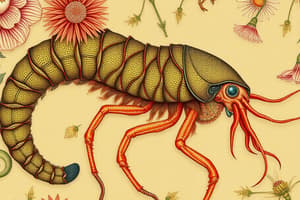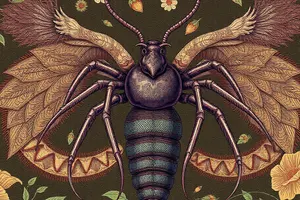Podcast
Questions and Answers
What are helminths?
What are helminths?
- Single-celled organisms that cause disease
- Bacteria that infect animals
- Fleas and ticks that affect external animal health
- Parasitic worms including nematodes, cestodes, and trematodes (correct)
What is one of the primary clinical signs of protozoan infections in animals?
What is one of the primary clinical signs of protozoan infections in animals?
- Weight gain and hyperactivity
- Diarrhea and lethargy (correct)
- Excessive grooming behaviors
- Increased appetite
Which diagnostic technique is specifically used to detect ectoparasites like mites?
Which diagnostic technique is specifically used to detect ectoparasites like mites?
- Imaging techniques
- Fecal examination
- Skin scraping (correct)
- Blood tests
Which of the following is a direct method of helminth transmission?
Which of the following is a direct method of helminth transmission?
What is an effective strategy for the control of helminth infections?
What is an effective strategy for the control of helminth infections?
Which species of ectoparasite is known for transmitting Lyme disease?
Which species of ectoparasite is known for transmitting Lyme disease?
What is the primary way in which Toxoplasma gondii is transmitted?
What is the primary way in which Toxoplasma gondii is transmitted?
What is the purpose of environmental control measures in parasite management?
What is the purpose of environmental control measures in parasite management?
Flashcards are hidden until you start studying
Study Notes
Veterinary Parasitology Study Notes
Helminths
- Definition: Parasitic worms, including nematodes (roundworms), cestodes (tapeworms), and trematodes (flukes).
- Life Cycle: Can be direct (host to host) or indirect (involving intermediate hosts).
- Common Species:
- Nematodes: Toxocara canis (dog roundworm), Ancylostoma spp. (hookworms).
- Cestodes: Dipylidium caninum (flea tapeworm), Taenia spp. (beef/pork tapeworms).
- Trematodes: Fasciola hepatica (liver fluke), Paragonimus spp. (lung fluke).
- Clinical Signs: Weight loss, diarrhea, vomiting, anemia, and impaired growth.
Ectoparasites
- Definition: Parasites that live on the skin or external surfaces of the host.
- Common Types:
- Fleas: Ctenocephalides felis (cat flea), Ctenocephalides canis (dog flea).
- Ticks: Ixodes scapularis (black-legged tick), Dermacentor variabilis (American dog tick).
- Mites: Sarcoptes scabiei (scabies mite), Demodex spp. (follicle mite).
- Disease Transmission: Can transmit pathogens causing diseases such as Lyme disease and ehrlichiosis.
- Clinical Signs: Itching, hair loss, skin lesions, anemia.
Prevention and Control
- Strategies:
- Regular deworming schedules for helminths.
- Flea and tick prevention (spot-on treatments, collars, oral medications).
- Good hygiene practices (cleaning living areas, removing feces).
- Vaccination: Some vaccines help reduce incidence of diseases transmitted by ectoparasites.
- Environmental Control: Treating environments (yard treatments, flea dips) to reduce parasite populations.
Diagnostic Techniques
- Fecal Examination: Identification of eggs or cysts in stool samples.
- Blood Tests: Serologic tests for antibodies against certain parasites (e.g., heartworm tests).
- Skin Scraping: Used to diagnose ectoparasites like mites.
- Imaging: Ultrasound or X-rays for detecting cysts or lesions caused by parasites.
Protozoa
- Definition: Single-celled organisms that can cause disease in animals.
- Common Types:
- Giardia spp. (intestinal protozoan).
- Toxoplasma gondii (can affect warm-blooded animals).
- Leishmania spp. (transmitted by sandflies).
- Transmission: Through contaminated food, water, or vector transmission.
- Clinical Signs: Diarrhea, weight loss, anemia, lethargy, organ-specific symptoms depending on the protozoan.
Helminths
- Parasitic worms include nematodes (roundworms), cestodes (tapeworms), and trematodes (flukes).
- Life cycles may be direct, involving transfer between hosts, or indirect, requiring intermediate hosts for development.
- Common nematodes include Toxocara canis (dog roundworm) and Ancylostoma spp. (hookworms).
- Common cestodes include Dipylidium caninum (flea tapeworm) and Taenia spp. (beef/pork tapeworms).
- Common trematodes include Fasciola hepatica (liver fluke) and Paragonimus spp. (lung fluke).
- Clinical signs of helminth infections can include weight loss, diarrhea, vomiting, anemia, and impaired growth.
Ectoparasites
- Ectoparasites live on the skin or external surfaces of the host, impacting their health.
- Common ectoparasites include fleas (Ctenocephalides felis in cats, Ctenocephalides canis in dogs), ticks (Ixodes scapularis, Dermacentor variabilis), and mites (Sarcoptes scabiei, Demodex spp.).
- Ectoparasites are known to transmit pathogens responsible for diseases such as Lyme disease and ehrlichiosis to their hosts.
- Clinical signs can manifest as itching, hair loss, skin lesions, and anemia.
Prevention and Control
- Effective strategies for parasite prevention include regular deworming for helminths and flea/tick prevention with spot-on treatments, collars, and oral medications.
- Maintaining good hygiene practices, such as cleaning living areas and removing feces, is essential to control parasite populations.
- Certain vaccines can help reduce the incidence of diseases associated with ectoparasites.
- Environmental control measures include yard treatments and flea dips aimed at reducing overall parasite populations.
Diagnostic Techniques
- Fecal examination allows for the identification of eggs or cysts present in stool samples, assisting in diagnosing helminth infestations.
- Blood tests, including serologic tests, can detect antibodies against specific parasites, such as those causing heartworm.
- Skin scraping techniques are utilized to diagnose ectoparasites, particularly mites.
- Imaging methods, such as ultrasound or X-rays, can help visualize cysts or lesions resulting from parasitic infections.
Protozoa
- Protozoa are single-celled organisms that can lead to various diseases in animals.
- Common protozoa include Giardia spp. (intestinal protozoan), Toxoplasma gondii (affects warm-blooded animals), and Leishmania spp. (linked to sandflies).
- Transmission routes for protozoa often involve contaminated food or water, or vector-mediated spread.
- Clinical signs may encompass diarrhea, weight loss, anemia, lethargy, and specific symptoms related to the affected organs based on the protozoan type.
Studying That Suits You
Use AI to generate personalized quizzes and flashcards to suit your learning preferences.




